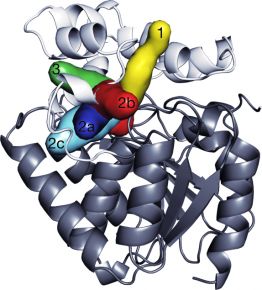An international team of scientists from the Czech Republic, Germany and Japan succeeded in developing an innovative method for improving the properties of enzymes. The method has the potential to be used in a variety of applications in the chemical, medical and food industries.

An international team of scientists from the Czech Republic, Germany and Japan succeeded in developing an innovative method for improving the properties of enzymes. The method has the potential to be used in a variety of applications in the chemical, medical and food industries. The study was published in the scientific journal Nature Chemical Biology.
The modified enzymes could be used, for example, in the elimination of very dangerous chemical substances that enter the environment as a result of human activity and which may be extremely harmful to human health and the environment. Nature is unable to break down many of these substances, however, in this study, the scientists developed an approach that can be applied to effectively remove them from the environment.
The heart of the discovery is based on genetic modification of the enzyme that generates and accelerates the chemical reaction. "Now we are able to use genetic changes to improve the properties of the enzymes so that they can remove dangerous substances from the environment more quickly and simply," says scientist Jiri Damborsky, one of the main researchers.
To date, scientists have focused during the changes in the properties of the enzyme on the structural site where the chemical reaction takes place - the active site. The modern method is based on the structural change of another complex in the enzyme - the access channels connecting the active site and the outer surface of the enzyme. "Unique computerized methods helped direct the practical research in order to prepare these canals whose availability for the decomposed materials was increased," says one of the researchers.
The scientists implemented their method by modifying an enzyme that was able to break down the highly toxic substance trichloropropane (TCP). The toxic substance, a colorless liquid, is a secondary product of chemical production. It may remain in the soil and groundwater for over a hundred years, is able to contaminate drinking water and may cause cancer. Using the innovative method, the protein engineers developed an adapted enzyme that was able to break down this toxic substance thirty-two times faster than the original enzyme.
However, the method has a wider application scope than only in the fight against dangerous substances and the preservation of the environment. The directed changes of the enzyme channels can be used in a variety of applied fields, including biomedicine and the food industry.

2 תגובות
For over a century man has been inventing and spreading in different ways as different containers for nature, today we are just beginning to understand the magnitude of the disaster. The chemicals create reactions in nature, new substances enrich the earth and slowly eliminate the variety of life on it.
Hasn't any of the smart scientists come to the conclusion yet that before playing with nature one should carefully check the possible consequences?
Any of the scientists can certainly give unequivocal proof that all the games in genetics will not have a devastating result on life on Earth, without the economic interest of a greedy and immoral corporation standing behind it.
A marginal example of our inability, humans, to see ahead:
Cigarettes, it used to be allowed to smoke everywhere, today it is clear that smoking is dangerous and not only harms the health of the smoker, but also the people around him, but the damage is even wider when millards of stubble soaked in toxic and carcinogenic substances pollute the earth, fresh water sources and the oceans and harm humans and animals.
Despite this, the tobacco corporations are celebrating, and the governments are collecting taxes.
Who assures us that when all the genetically modified genes meet by chance in nature they will not break down and create genetic mutations that will change the face of life on earth or at worst destroy them?
Why did you delete my comment?